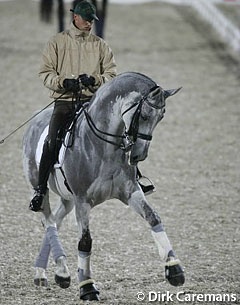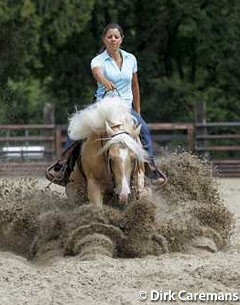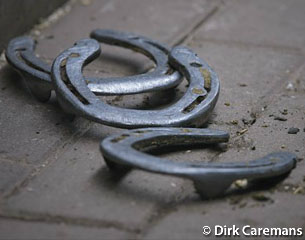
A major part of training is accommodating, adapting, preventing, or avoiding the many aspects of riding that we cannot control! The four major ones that come to mind include weather, weakness, pain and time.
Weather is an element that every rider must face and no matter how fantastic your riding facilities are there will always be times when weather will effect your training. Rain is obvious and for the many who do not have the luxury of an indoor school, rain can cause major training interruptions. I was once asked, "why the hell were you just riding in the rain when we have an indoor?" Whilst I could have ridden in the shelter of the indoor arena, I chose this day to ride in the rain for one major reason. It can, and more than often does rain at competitions, and there is no point arriving on the day of the test, to realize your horse can't stand being out in that kind of weather! Not only should you get your used to training in the rain, but also training the test in the rain, as we have all seen the horse that trots up on the most beautiful straight centerline, halts to perfection, and then attempts to turn his back end towards the frontward pelt!
The same goes for wind, heat, flies, dust. If you never let your horse experience these kinds of conditions then how can you expect him to go well when you are out, which is already a scene with a more heightened atmosphere. However while you must allow your horse to be familiar with these conditions you must also be smart about it. Don't ride him out in the wind if you know you don't have solid control! Don't ride around in the rain for long periods if it is freezing and don't fly around in the heat for hours on end just to test your stamina. Gently introduce these aspects into training, but never avoid them completely.
The second unavoidable aspect is weakness, which of course comes in many shapes and sizes and can be both horse or human related to varying degrees. Sometimes a weakness can be so great that the entire training focus throughout the horse's entire working life must be tailored to accommodate his specific floor and the same goes for the rider. If a rider has a weaker left leg, or pulls too much on the right rein, the teaching they receive for their riding career will need to constantly monitor these weaknesses, to ensure the rider can manage them and continually improve on them during training. On the other hand, a horse's weakness can be anything from a hollow back, a tendency to put weight in the shoulders, to more simply a mind that is easily distracted. With all of these weaknesses a rider must continually accommodate and monitor their existence, and while a lot of them can be improved, the minute these aspects are forgotten they will appear, time and time again!
Pain. If you ask a rider if they have back pain and they tell you never, I either don't believe them, or wonder that perhaps they are not really riding! If you watch professional horse riders walk home after a long day, it is more like a waddle than a walk, often with one hand supporting the lower back! Pain, particularly back pain, is something we must all accommodate and sometimes it can be simple things like not riding in the morning, as you know that's when the pain is at its worst.
Time is something we all seem to run out of, whether it be because our kids have to be picked up from school, the farrier is coming, we are already late for work, we all have to mould our training around certain time schedules. A simple way to maximize your time is of course to keep a daily agenda, but if you are not that organized then obvious things like having your tack room well organized to cut down the preparation time, and, when added up, can actually make a difference. On the other hand, there are many aspects of training that we can control and by using our head and, unfortunately, sometimes our bank account more effectively, we can make a major difference on our training success.
 The four things that come to mind here is surface, shoeing, saddlery and safety. If anyone tells you that the surface doesn't play a part in dressage, or in fact any horse training, then they have never ridden on a top surface. The technological and informational developments in the study of equine surfaces has grown more and more popular, and companies that specialise in this area are finding more and more demand for high end products.
The four things that come to mind here is surface, shoeing, saddlery and safety. If anyone tells you that the surface doesn't play a part in dressage, or in fact any horse training, then they have never ridden on a top surface. The technological and informational developments in the study of equine surfaces has grown more and more popular, and companies that specialise in this area are finding more and more demand for high end products.
Accommodating to one of the things we can't control, the weather, the right surface can help ensure a good ride more days out of the year, which you will appreciate if you have ever tried to dig holes to drain out a soggy menage! While installing professional footing may shake the bank balance, the cost incurred on a top surface may help reduce costs elsewhere, as poor riding conditions are like us running on rocky ground and will often impact on our own medical bill.
Another aspect of dressage riding that we can control is shoeing and once you have established the correct surface, you need to make sure your horse has the outfit to dance on it pain free. "A correctly made shoe gives both equilibrium and comfort to the horse," international farrier Sérgio Pinto explained. "Without the correctly fitted shoe, the way the horse moves and its will to do the exercises, will be compromised!"
Often confronted with difficult shoeing histories, Sergio stated that there is a lot more involved in corrective shoeing than simply fitting the horse with new irons. If done correctly it can have a huge impact on the horse's way of going. "Unfortunately, I see some horses that could have better movement and will to do the exercises, if they were correctly shod. But correcting bad shoeing is very complicated to describe! It is only possible to arrange a solution after checking the horse's lines, the hoof and the way it is moving. Each bad shoeing case is unique." Having a major impact of the horse's willingness and ability to move, bad shoeing puts the horse out of balance and can make him very uncomfortable. "The biggest difficulty is to balance the best equilibrium of the horse with the correct choice of shoes depending on the discipline the horse practices and the ground it usually works on (hard or soft)," Sergio added.
Accompanying Portuguese Olympic rider Goncalo Cavalho to the London Games, Sergio knows what is required in the sport of dressage and knows that this only heightens the importance of the right shoes! "Dressage is very demanding, as the horse has to have a correct equilibrium, good movement, big amplitude and a good biomechanics; a right shoe has to provide all of this. I often have people telling me how much better the horse feels and moves after we find the right shoeing solution. However, with some situations the results are immediate, while others may take quite some time."
A poor workmen blames his tools, so to make sure you are excuse free, you also need to have the right gear for your horse. "It is very important to have a well fitted saddle and bridle, both for the comfort of the horse and the rider," said Australian saddler Peter Wagner. "The horse cannot perform to his best ability if he is uncomfortable and the rider will not sit correctly if the saddle is not sitting in a balanced correct position. The saddle must sit evenly not tipping forward or backwards as this will affect the rider's position and it will create incorrect pressure points for the horse, which in turn would not allow him to move as well as possible , it would in fact over time make him sore in the muscles and possibly make him unwilling in his work."
Saddler and owner of his family business for over 33 years, Wagner was himself a competitive showjumper and is now breeder and owner of some very special young talents. "We now have dressage horses from young ones to GP, including one with Patrik Kittel in Germany, so we know the importance of having correctly fitted gear!” Peter acknowledges that having the wrong gear can have a major impact on the horse's movement, trainability and overall attitude. "The bit makes an enormous difference to the horse, as if you do not have a horse with a comfortable correct fitting bit then he will not be able to be in the right contact or “ on the bit’’ . This situation occurs as all horses are different and will not all go well in the same bit .”
 To be sure you are using the right gear, Peter believes it is always wise to ask an expert as well as check with your trainer. "He or she should be able to check your gear and then advise you if changes need to be made. Hopefully they can recommend a saddler that can help. Unfortunately these days there are lots of retail saddlery stores which do not have a qualified saddler on the premises. Sadly it is a dying art!"
To be sure you are using the right gear, Peter believes it is always wise to ask an expert as well as check with your trainer. "He or she should be able to check your gear and then advise you if changes need to be made. Hopefully they can recommend a saddler that can help. Unfortunately these days there are lots of retail saddlery stores which do not have a qualified saddler on the premises. Sadly it is a dying art!"
If you think you may be riding with the wrong tools, the horse will usually tell you, and you will for sure know when you get it right! "If the horse is not going well, or the rider feels like they are struggling with their position, then this would be a very good time to have their gear checked by an expert," Wagner expained.
Once you are on top of the surface, the feet and the saddlery, then the safety of you and your horse must be prioritized. There is a very big difference between being scared, and being sensible. "You're just not riding outside because you're scared of the wind!" or "You don't need to lunge him, you're just frightened to hop straight on" are two classic lines, typically from people standing safely on the sidelines! A rider who knows her horse will know what he can and can't handle, and making the right decision in regards to safety is a personal one that no-one else can or should be the judge of.
Yes, you do need to get your horse used to different conditions, but if a simple choice makes the difference between you staying on top of the horse, then always be confident that you have made the right one. Finally, from a vet's opinion, Dr Tom Schell DVM believes there are many ways we can improve our chance of training success, and most come down to having the right knowledge. "The level of fitness directly impacts training ability due to reflection of stamina," said Schell. "Obviously, if one is fit then they might be able to compete at higher levels and for longer periods of time and not be winded or exhausted. Fitness also impacts blood circulation, cardiovascular health and muscle development, all of which are positive and impact training as well as competition.”
Dr Schell advises that proper nutrition, consistent exercise, and maintaining a good body condition and mental attitude, are all things that can help increase a horse's physical fitness. With the resting heart rate of an elite equine athlete being in the range of 28-35 bpm (beats per minute), whether they are a dressage horse or race horse, a rider should be aware of their horse's rate. "The fitter the condition, the lower the resting heart rate due to improved circulation, nutrient utilization as well as cardiac function. Overweight and less fit horses tend to have higher heart rates, but the average heart rate of a horse is around 40 bpm," said Schell.
Surface area, correct shoeing, or even dental care, are all issues that Dr Schell knows make a great impact on the horse's ability in the dressage arena. "The surface can impact the horse positively or negatively. Too firm of a surface leads to increased concussive forces on the joints, tendons, muscles as well as feet, leading to increased wear, tear and strain," Schell explained. "Too soft of a surface can also lead to potential for injury due to over-extension of joints as well as footing issues, which then can lead to injury due to excessive strains."
In terms of correct shoeing protocol, it must be catered to the individual horse and their needs. "The ideal shoe will allow the horse to travel fluidly with a proper gait and no interference and with proper weight distribution," Schell added. "The shoe should also protect the hoof, allow for enhanced traction when needed and improve force distribution."
As for teeth, they are continually erupting until around the age of 20+ years, which means that they also grow in length or size. "The upper jaw is wider than the lower jaw and the teeth on the upper and lower jaws come into contact with one another and "wear" or grind against each other over time, which keeps them worn down to a certain degree. The overall problem that develops is the formation of uneven or sloping
surfaces. These points can lead to pinching of the cheeks as well as tongue. Proper dentition also allows for the placement of the bit and a comfortable mouth overall when bitted and during competition. If the mouth is out of alignment or there are points present, this could create not only pain for the horse but also an imbalance when bitted, which will result in poor behavior or response to the rider."
Equally important is for rider to be aware of the horse's state not just in training, but in the crucial time before and after. "Quite possibly the most common problem that I have seen in horse care is a lack of cooling down the horse or feeding too soon post exercise, which can lead to signs of colic as well as electrolyte disturbances," said Schell.
While one of these problems on its own may have a lesser impact, it is thinking about the care and training of your horse in its entirety that will ensure your success and mutual happiness. "Overall, I feel that the biggest mistake an active competitor makes regarding their horse is forgetting the impact of proper nutrition, proper exercise etiquette as well as maintaining the feet or hooves," Schell concluded.
by Sarah Warne
Related Link
Classical Training Articles by Sarah Warne